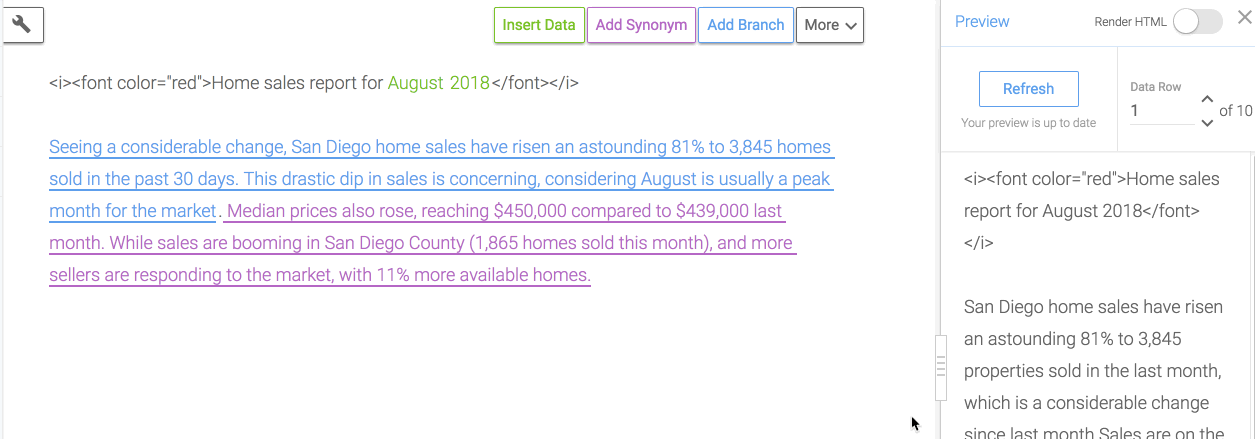Wordsmith Hacks
Check out these shortcuts and features to help you use Wordsmith more efficiently!
Undo
You can “undo” and “redo” actions in the Wordsmith Template Editor just like a word processor, browser, or other program. Use “undo” if you make a mistake or want to revert an action you made or text you typed, and “redo” to move forward in your action history. They’ll work on anything in your Template – typing and deleting, even adding Branches or Synonyms. Just right click in the Template and select “undo” or “redo”. Or use your keyboard shortcuts: command + Z or command + Y on Macs, and control + Z or control + Y on PCs.
The Back button
When creating nested Branches and Synonyms, you may find yourself a few levels deep within a sentence. You can use the "Back" button you see in the Branch or Synonym pane to navigate back to the previous branch or main editor. And you can also use your browser's normal back button to get back to the previous Branch.
Copy & paste
Meet Copy and Paste, they're your new best friends. You can use your normal shortcuts (command/control+c, command/control+v) or mouse to copy and paste words, Branches, Synonyms, everything in your Wordsmith Template. We'll preserve the Branch structure, the Synonyms, and the formatting you've set for your data. You can even copy and paste across Templates. Although, if you want to copy a whole Template, it's easier to Duplicate it.

A / An
If you're wondering how to account for "a" or "an" before a Data Variable, Branch, or Synonym that could change, look no further! Wordsmith will do it for you. Just type "a" before the word or words that can change and Wordsmith will update it to be grammatically correct in your narratives. If you don't need this feature, you can turn it off from your Project Settings page.

Enter & tab for synonyms
Use the 'Tab' key on your keyboard as a shortcut for adding a new Synonym. You'll first create the Synonym by clicking the "Add Synonym" button. Then you can either click the "Add another Synonym" link below your first word or hit 'Tab' to add another Synonym.
Un-branch that branch or synonym
Remember when we said copy and paste were your best friends? Now you'll see why. Be warned, this one's a bit hacky (and we plan on making this process easier in the app soon).
You'll want to do this when you create a Branch or Synonym and then decide that you actually don't want that word, phrase, or sentence to be a Branch or Synonym any longer. Don't delete the Branch or Synonym by clicking on the "X" next to it as that will remove all of the text you've written. To return that text to the main body of your Template, copy what you've written in the "Then write:" box, exit out of the Branch or Synonym by clicking the "Done" button, and paste your text back into main Template. Then you can feel free to delete the Branch or Synonym because you'll still have the text you wrote.
HTML and Markdown
If you'd like your narratives to include text formatting like bold, italics, hyperlinks, and more, you can use HTML or Markdown in your Wordsmith Templates. You can use the toggle in the Preview or on the Review page to render the HTML in your Template. But keep in mind, markdown will not be rendered in Wordsmith.

You can use the toggle inside the Preview pane to see HTML rendered.

You can use the toggle in the upper right corner of the Review page to see HTML rendered.
Unfamiliar with writing HTML? Markdown is a lightweight syntax you can use to style your writing. And because it just uses common symbols, it's easy for anyone to use without coding. To use Markdown in Wordsmith, you'll add the appropriate symbols for bold, italics, a bulleted list, or anything else. Here's a Markdown Syntax Guide.
Once you have your Wordsmith content by either downloading it or accessing our API, you can convert those Markdown symbols to HTML. There are a lot of free Markdown-to-HTML converters out there, we like Zapier and Marked.
Updated over 6 years ago
